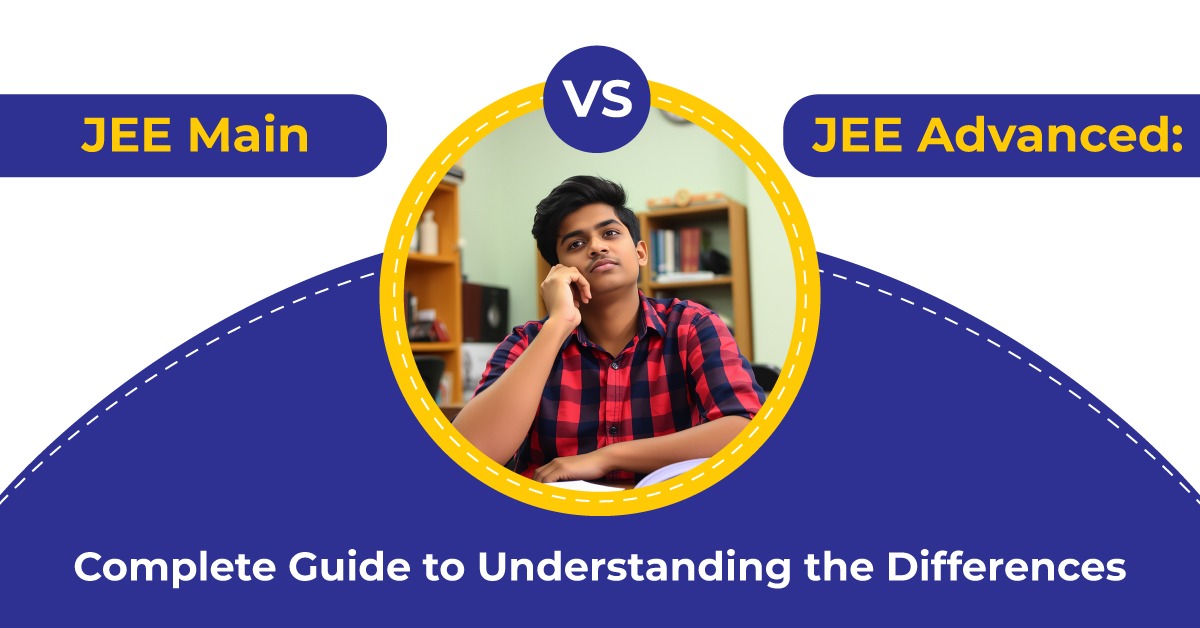
The engineering entrance examination system of India works in a two-tier manner that decides the admissions to the best technical institutes of the country. The Joint Entrance Examination is the entrance to the undergraduate engineering education, however, one needs to know the difference between JEE Main vs Advanced for them to be the future engineers. JEE Main is a footstep towards NITs, IIITs, and other Govt. funded Technical Institutions. Besides, it is the qualifying exam for JEE Advanced which opens the doors of prestigious IITs. Thus, the whole two-stage process is mandatory for the students targeting the best engineering colleges.
Understanding the Examination Structure: JEE Main vs JEE Advanced
JEE Main: Gateway to Engineering Education
JEE Main is the leading engineering entrance test which is aimed at the largest group of all aspirants. The examination is split into two different papers according to the chosen academic path. Paper 1 is meant for students who want to get into BE or BTech programmes, these being the most favoured engineering streams.
Paper 2 is designed for the candidates who opt for disciplines related to architecture and planning, namely, BArch and BPlanning courses. Besides the main pathways, Paper 1 scores are accepted by many institutions for various programmes like Integrated MSc, Integrated MTech, Integrated BTech–MBA, Bachelor of Science, Bachelor of Design, and other specialized academic offerings.
The Two-Session Advantage in JEE Main
The 2026 admission cycle marks the beginning of the JEE Main dual-session framework which has been designed for the benefit of the candidates. This system indeed lets the students take the exam for two times within one academic year, still, it is up to the student whether he/she wants to take both sessions or just one.
The initial session is like a trial run where candidates can go through all the stages of the exam, such as the method of asking questions, the degree of difficulty, and evaluation. With the help of this personal experience, students can work on their tactics and not repeat the mistakes they made in the first attempt during the second one. In case of two attempts, the NTA keeps only the higher score for the final merit list which thereby ensures that no candidate suffers loss due to a poor performance in one of the sessions.
JEE Advanced: The IIT Entrance Challenge
Eligibility and Selection Criteria
JEE Advanced, conducted annually by one of the IITs on a rotating basis, is the last barrier for students wishing to be part of the IIT system. This test assesses the candidates for all the undergraduate programs that are offered at Indian Institutes of Technology. Nevertheless, the access is still limited—the only ones who make it are the best 2.5 lakh participants from JEE Main who are able to compete in this stage of the examination.
Difficulty Level and Assessment Philosophy
The gap in terms of difficulty between JEE Advanced and JEE Mains is huge and very deliberate. JEE Advanced does require an extremely deeper understanding of concepts, better analytical skills, and even more than “normal” problem-solving abilities than the previous one. The test is not only going to be about recalling the knowledge but also about taking the concepts to higher, more intricate, and less straightforward problems where an unconventional solution has to be found.
Key Differences: JEE Main vs JEE Advanced
Attempt Limitations
The attempt policies for both exams are very different from each other, showing their different purposes. JEE Main is very flexible and will allow students to take the exam in three consecutive years, with two chances each year, making a total of six possible attempts. The long time allows for different personal situations and preparation timelines.
On the other hand, JEE Advanced has very strict limitations: candidates can only take the exam twice, and those attempts have to be done in two consecutive years. This restriction places a lot of emphasis on intensive preparation and keeps the selective nature of the admissions process for IITs.
Examination Format and Question Types
JEE Main vs JEE Advanced greatly differs also in the aspect of the examination structure. The whole JEE Main BE/BTech paper consists of one session with Multiple Choice Questions (MCQs) combined with numerical answer-type questions, making the grading system relatively easier.
JEE Advanced, however, takes a much broader approach through two compulsory papers, which are all to be done by all applicants. The papers have a great mix of question types, such as multiple-choice questions, numerical value questions, and integer-type responses. This combination of question types does not only test different cognitive skills but also makes it hard for students who rely on pattern-based preparation methods.
Choosing Your Path
Comprehending the connection between JEE Main and JEE Advanced allows students to come up with right preparation plans. Although JEE Main acts as the basic exam with wider reach, JEE Advanced acts as the specific filter for the most advanced engineering institutions in India. Obtaining a good score in both exams requires hard work, nonetheless, awareness of their differences allows applicants to customize their preparation rightly, thus increasing their likelihood of enrolling in the institutions of their choice.







0 Comments